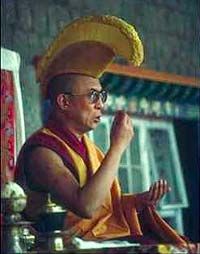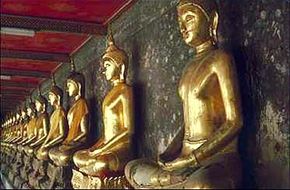Buddhist Nirvana
The term nirvana is associated with both Hinduism, the oldest religion in the world, and Buddhism, its best known off-shoot. In both Hinduism and Buddhism, the word refers to a higher state of being, but the two religions view this state very differently. As it turns out, examining the distinction between the concepts of nirvana is an excellent way of understanding some of the major differences between the two religions.
Nirvana is mainly associated with Buddhism, which was born out of Hinduism in Asia back in the 5th century B.C. It began as a movement within Hinduism, based on the philosophy and life of a man named Siddhartha Gautama, and eventually diverged to form its own path.
Advertisement
Siddhartha Gautama, who later became the Buddha ("the awakened one"), was born to a rich, ruling family around 563 B.C. in what is now modern Nepal. According to Buddhist legend, he led a sheltered, pampered life for all of his childhood and well into his twenties.
As a young man, he began to question the spiritual worth of this luxurious life and decided to give up all his possessions and emotional attachments, including his wife and young son. He wanted to understand the true nature of life and saw all his attachments as distractions, in keeping with Hindu thought.
He became a shramana, a wandering, homeless ascetic dedicated to meditation. He hoped to find enlightenment by completely detaching himself from the world, swinging to the polar opposite of his earlier life. Over time, he removed himself farther and farther from the earthly world, to the point that he was close to starvation. But he still hadn't achieved enlightenment.
He decided that if he continued on that path, he would die without reaching any understanding, so he gave up the ascetic life and accepted a meal from a stranger. He decided to take the middle road, the life between the luxury he had known and the poverty he had known.
According to legend, soon after Siddhartha took this path, he finally achieved enlightenment. As he meditated under a tree, he saw all of his past lives, and then the past lives of others. Eventually he gained a perfect, omniscient knowledge of this world and the world beyond it.

In Buddhism, this state, which the Buddha couldn't relate in language, is called nirvana. The word is Sanskrit for "to extinguish." In this case, it means to extinguish ignorance, hatred and earthly suffering. The term is most closely associated with Buddhism, though it's applied to a similar concept in Hinduism (as we'll see later on).
By achieving nirvana, you can escape samsara, the cycle of reincarnation that characterizes both Hinduism and Buddhism. In each life, a soul is punished or rewarded based on its past actions, or karma, from the current life as well as earlier lives (which also include lives as animals). It's important to note that the law of karma isn't due to a god's judgment over a person's behavior; it's closer to Newtons law of motion -- every action has an equal and opposite reaction. It happens automatically, of its own accord.
When you achieve nirvana, you stop accumulating bad karma because you've transcended it. You spend the rest of your life and sometimes future lives "working off" the bad karma you've already accumulated.
Once you have fully escaped the karmic cycle, you achieve parinirvana -- final nirvana -- in the afterlife. As with Hindu nirvana, souls that have achieved parinirvana are free of the cycle of reincarnation. The Buddha never specified what parinirvana was like. In Buddhist thought, it is beyond normal human comprehension.
In the next section, we'll find out what the Buddha prescribed for achieving nirvana on earth and parinirvana in the afterlife.
